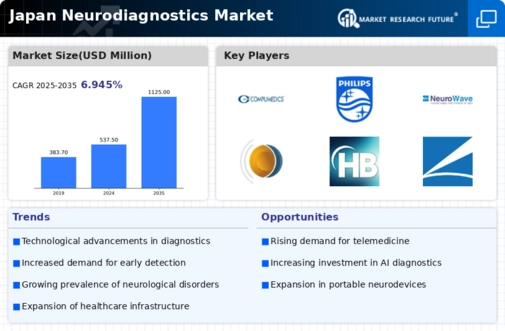Growing Awareness of Mental Health
There is a notable increase in awareness regarding mental health issues in Japan, which is driving the neurodiagnostics market. Public campaigns and educational initiatives are encouraging individuals to seek help for mental health conditions, such as depression and anxiety disorders. This heightened awareness is likely to result in a greater demand for neurodiagnostic services, as healthcare providers aim to offer comprehensive assessments for mental health conditions. The market could see a growth rate of around 6% as more individuals seek neurodiagnostic evaluations to better understand their mental health. This trend underscores the importance of integrating neurodiagnostics into mental health care, thereby expanding the market's reach.
Investment in Research and Development
Investment in research and development (R&D) within Japan's healthcare sector is significantly influencing the neurodiagnostics market. The government and private entities are allocating substantial funds to develop advanced diagnostic technologies, including neuroimaging and electrophysiological techniques. In 2025, R&D spending in the medical technology sector is projected to reach ¥1 trillion, with a notable portion directed towards neurodiagnostics. This influx of capital is likely to foster innovation, leading to the introduction of more accurate and efficient diagnostic tools. Consequently, the neurodiagnostics market may experience accelerated growth as new technologies emerge, enhancing diagnostic capabilities and improving patient outcomes.
Technological Integration in Healthcare
The integration of advanced technologies into healthcare systems in Japan is a significant driver for the neurodiagnostics market. Innovations such as artificial intelligence (AI) and machine learning are being increasingly utilized to enhance diagnostic accuracy and efficiency. Hospitals and clinics are adopting these technologies to streamline neurodiagnostic processes, which may lead to improved patient outcomes and reduced costs. The market is expected to grow by approximately 7% as healthcare providers leverage these technologies to optimize their diagnostic capabilities. This trend indicates a shift towards more data-driven approaches in neurodiagnostics, potentially transforming the landscape of neurological assessments in Japan.
Rising Incidence of Neurological Disorders
The increasing prevalence of neurological disorders in Japan is a primary driver for the neurodiagnostics market. Conditions such as Alzheimer's disease, Parkinson's disease, and epilepsy are becoming more common, with estimates suggesting that around 4.6 million individuals are affected by dementia alone. This rising incidence necessitates advanced diagnostic tools to facilitate early detection and effective management of these conditions. As the population ages, the demand for neurodiagnostic services is expected to grow, potentially leading to a market expansion of approximately 8% annually. The neurodiagnostics market is thus positioned to benefit from this trend, as healthcare providers seek innovative solutions to address the growing burden of neurological diseases.
Regulatory Support for Diagnostic Innovations
Regulatory support for innovative diagnostic solutions is playing a crucial role in shaping the neurodiagnostics market in Japan. The Pharmaceuticals and Medical Devices Agency (PMDA) is actively promoting the approval of novel diagnostic tools, which encourages manufacturers to invest in new technologies. This supportive regulatory environment is likely to expedite the introduction of advanced neurodiagnostic devices, fostering competition and innovation within the market. As a result, the neurodiagnostics market may witness a growth trajectory of around 5% as new products enter the market, enhancing the overall diagnostic landscape and improving access to essential neurodiagnostic services.




















Leave a Comment